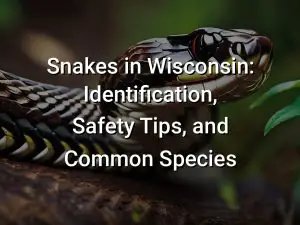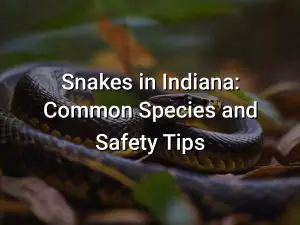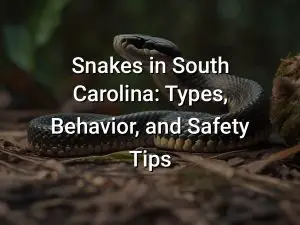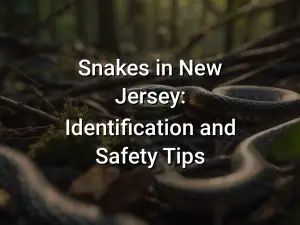Snakes in Virginia: A Comprehensive Guide (Safety & What You Need to Know)
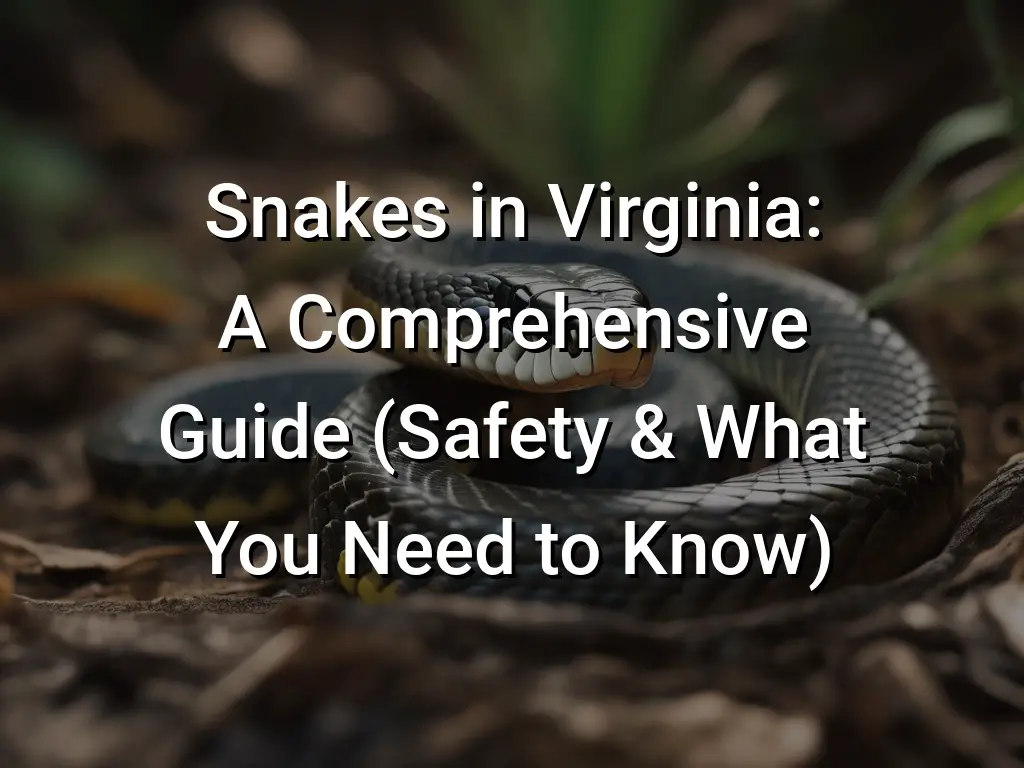
Virginia, known for its rich history and beautiful landscapes, is also home to a variety of snake species. These slithering creatures may elicit fear in some, but they play an important role in the ecosystem. In this comprehensive guide, we’ll take a closer look at the snakes found in Virginia, including information about their habitats, behavior, and safety tips for encountering them in the wild.
From the venomous Eastern Copperhead to the harmless Eastern Worm Snake, Virginia is home to a diverse range of snake species. Whether you’re a nature enthusiast or simply curious about these fascinating creatures, this guide will provide you with valuable insights and knowledge to help you better understand and appreciate the snakes that call Virginia home.
Quick Links
Introduction
Virginia is home to a variety of snake species, some of which are venomous and pose a potential danger to humans. It’s important to be knowledgeable about these snakes and understand how to safely interact with them or avoid them altogether. This comprehensive guide will provide you with essential information about the different snake species found in Virginia, their habitats, behavior, and safety tips to ensure you can coexist with these fascinating creatures.
Eastern Copperhead
The Eastern Copperhead is a venomous snake commonly found in Virginia. It is easily recognizable by its distinctive copper-colored head, which is why it is aptly named. This snake has a stout body and can grow to be about 2-3 feet long.
Eastern Copperheads are typically found in wooded areas, rocky hillsides, and near water sources such as rivers and streams. They are known to be active during the day and are most commonly spotted during the spring and fall when they are more active.
While the Eastern Copperhead is venomous, it is important to note that it is not usually aggressive towards humans. It will generally only bite if it feels threatened or cornered. If you encounter a Copperhead, it is best to keep a safe distance and give the snake space to move away.
If you do get bitten by an Eastern Copperhead, it is crucial to seek medical attention immediately. Copperhead bites can be painful and potentially dangerous, especially if left untreated.
To avoid encounters with Eastern Copperheads, it is recommended to stay on designated trails when hiking and to wear sturdy shoes or boots to protect your feet. Additionally, be cautious when lifting rocks or other debris, as Copperheads may seek shelter underneath.
Remember, snakes play an important role in the ecosystem and should be respected and admired from a safe distance. By being aware of their presence and taking precautions, you can safely coexist with these fascinating creatures.
Northern Water Snake
The Northern Water Snake is a common species of snake found in Virginia and throughout the eastern United States. It is a non-venomous snake that is often mistaken for a venomous snake due to its aggressive behavior and similar appearance to the venomous Cottonmouth snake. However, the Northern Water Snake poses no threat to humans and is beneficial in controlling populations of rodents and other pests.
The Northern Water Snake is typically found near bodies of water such as rivers, streams, ponds, and marshes. It is a strong swimmer and is known to spend a significant amount of time in the water, hunting for small fish, amphibians, and other aquatic prey.
Adult Northern Water Snakes can grow to be around 2-4 feet in length and have a thick, muscular body. They are typically brown or gray in color with dark bands or blotches along their bodies. Juvenile water snakes may have a more vibrant pattern with reddish or orange bands.
If encountered, the Northern Water Snake may exhibit aggressive behavior, such as vibrating its tail, hissing, or striking. However, these are defensive behaviors and the snake will generally try to escape rather than engage in confrontation. It is important to remember that the Northern Water Snake is non-venomous and not a threat to humans.
If you come across a Northern Water Snake, it is best to observe it from a distance and allow it to move away on its own. It is illegal to harm or kill snakes in Virginia, as they play an important role in the ecosystem. If you have concerns about a snake in your yard or near your home, it is recommended to contact a professional wildlife removal service.
Overall, the Northern Water Snake is a fascinating and beneficial snake species that plays an important role in Virginia’s ecosystem. By understanding and respecting these snakes, we can coexist with them safely and appreciate their contributions to the natural environment.
Eastern Rat Snake
The Eastern Rat Snake, also known as the Black Rat Snake, is a common snake species found in Virginia. It is non-venomous and can grow up to 6 feet in length. These snakes are known for their black or dark brown coloration, sometimes with lighter markings along their body.
Eastern Rat Snakes are excellent climbers and are often found in trees or other elevated areas. They are skilled hunters and feed on small mammals, birds, and eggs. These snakes are also beneficial to have around as they help control rodent populations.
If you encounter an Eastern Rat Snake, it is important to remember that they are not aggressive and will generally try to avoid humans. If threatened, they may hiss or vibrate their tail as a warning. It is best to give them space and allow them to move away on their own.
It is also important to note that Eastern Rat Snakes are protected under Virginia law and it is illegal to kill, harm, or capture them without a permit. If you have a rat snake on your property that you would like to have removed, it is recommended to contact a professional wildlife removal service.
Overall, Eastern Rat Snakes are a fascinating species to observe in their natural habitat. They play an important role in Virginia’s ecosystem and should be appreciated and respected.
Corn Snake
The corn snake (Pantherophis guttatus) is a non-venomous snake species that is native to the southeastern United States, including Virginia. They are medium-sized snakes, typically measuring between 3 and 5 feet in length. Corn snakes are known for their vibrant colors and patterns, which can vary greatly between individuals.
Corn snakes are excellent climbers and can often be found in trees, as well as in grasslands, forests, and abandoned buildings. They are primarily active at night and are adept hunters, feeding on small rodents, birds, and other small animals.
Despite their intimidating appearance, corn snakes are generally docile and non-aggressive towards humans. They are popular pets among reptile enthusiasts due to their relatively easy care requirements and attractive appearance. Corn snakes can live for 15 to 20 years in captivity if provided with proper care.
If you encounter a corn snake in the wild, it is best to observe it from a safe distance and refrain from attempting to handle or disturb it. Corn snakes, like all wildlife, should be appreciated and respected in their natural habitat.
When it comes to snake encounters in Virginia, it is important to remember that the state is home to both venomous and non-venomous snakes. It is crucial to familiarize yourself with the different snake species in the area and learn how to identify venomous snakes to ensure your safety and the well-being of the snakes. If you are unsure about the species of snake you have encountered, it is best to contact a professional wildlife expert for assistance.
Eastern Kingsnake
The Eastern Kingsnake is a non-venomous snake native to Virginia. It is known for its distinctive black and yellow or black and white banding, which resembles that of a venomous snake, the Eastern Coral Snake, and serves as a form of mimicry for protection.
The Eastern Kingsnake is primarily found in forested areas, but it can also be found in grasslands, wetlands, and suburban areas. It is a constrictor, meaning it subdues its prey by coiling around it and squeezing until it can no longer breathe.
This species primarily feeds on small mammals, birds, reptiles, and amphibians, making it an important predator for controlling populations of rodents and other pests. It is also known to eat venomous snakes, such as Copperheads and Rattlesnakes, making it a valuable asset in keeping their populations in check.
Eastern Kingsnakes are typically docile and non-aggressive towards humans. However, if threatened, they may flatten their head, hiss, vibrate their tail, or even strike as a defensive response. It is important to give them space and avoid handling them unless you are a trained professional.
If you encounter an Eastern Kingsnake in Virginia, it is best to leave it alone and appreciate it from a safe distance. They play a vital role in maintaining the ecosystem’s balance and should be allowed to carry out their natural behaviors undisturbed.
Eastern Garter Snake
The Eastern Garter Snake, also known as the Common Garter Snake, is one of the most widespread snake species in Virginia. It is a non-venomous snake and is easily recognizable by its long, slender body and distinct stripes running along its back.
The Eastern Garter Snake is typically found in a variety of habitats, including woodlands, meadows, marshes, and even urban areas. It is a highly adaptable snake that can thrive in different environments and is often seen near water sources.
While the Eastern Garter Snake is not venomous, it may bite if it feels threatened or cornered. However, the bite is usually harmless and rarely requires medical attention. If you encounter an Eastern Garter Snake, it is best to observe it from a distance and avoid disturbing it.
These snakes play an important role in controlling rodent populations and are generally beneficial to have in the ecosystem. They primarily feed on small mammals, frogs, and earthworms.
If you have a garden or backyard, you might come across an Eastern Garter Snake hunting for prey. They are known to be excellent climbers and can often be seen basking in the sun on rocks or tree branches.
It is important to note that while the Eastern Garter Snake is non-venomous, there are venomous snake species in Virginia. It is essential to be able to differentiate between different snake species and know how to respond in case of a snake encounter.
Remember to always give snakes their space and avoid unnecessary interactions. If you come across a snake and are unsure of its species or behavior, it is best to contact a local wildlife expert or animal control for assistance.
Northern Black Racer
The Northern Black Racer is a common snake found in Virginia. It is a non-venomous species and belongs to the Colubridae family. The snake gets its name from its shiny black color and slender body.
The Northern Black Racer can grow up to 5 feet in length and has a smooth and glossy appearance. It is known for its speed and agility, hence the name “racer.” It can move swiftly across the ground and climb trees and other structures with ease.
This snake is primarily found in open habitats such as fields, meadows, and forest edges. It is a diurnal species, meaning it is active during the day. The Northern Black Racer feeds on a variety of prey, including insects, rodents, birds, and other small snakes.
When threatened, the Northern Black Racer will often flee rather than bite. It is a skittish snake and prefers to avoid confrontation. However, if cornered or provoked, it may strike and bite. Although its bite is not venomous, it can still cause pain and should be treated with proper care.
It is important to note that the Northern Black Racer is a beneficial snake to have in your environment, as it helps control populations of rodents and other pests. If you encounter a Northern Black Racer, it is best to observe it from a distance and allow it to go on its way.
Remember, snakes play an important role in the ecosystem and should be respected and admired from a safe distance. If you have any concerns about snakes on your property, it is recommended to contact a professional wildlife removal service for assistance.
Eastern Hognose Snake
The Eastern Hognose Snake, also known as Heterodon platirhinos, is a unique and fascinating snake species found in Virginia. It is known for its distinctive upturned snout, which gives it the appearance of a small pig or hog, hence the name “hognose.”
The Eastern Hognose Snake typically grows to a length of 20 to 33 inches, with females being larger than males. It has a broad, flattened head and keeled scales, which give it a rough texture. Its coloration can vary, but it is usually brown, gray, or yellow-brown, with dark brown blotches or speckles along its back.
One of the most interesting characteristics of the Eastern Hognose Snake is its defensive behavior. When threatened, it will flatten its head, inflate its body, and hiss loudly. It may also strike with a closed mouth or play dead, rolling onto its back and sticking out its tongue. This dramatic display is intended to intimidate predators and make them believe that the snake is venomous, although the Eastern Hognose Snake is actually harmless to humans.
The Eastern Hognose Snake is primarily found in sandy or gravelly habitats, such as pine forests, sand dunes, and coastal plains. It is a skilled burrower and is often found hiding under leaf litter, logs, or rocks. It feeds primarily on toads, although it may also eat frogs, salamanders, and small mammals.
If you encounter an Eastern Hognose Snake in the wild, it is best to observe it from a safe distance and avoid disturbing it. Remember that snakes play an important role in the ecosystem and should be respected and protected. By understanding and appreciating the unique characteristics of snakes like the Eastern Hognose Snake, we can coexist with these fascinating creatures in harmony.
Timber Rattlesnake
The Timber Rattlesnake, also known as the Canebrake Rattlesnake, is a venomous snake species found in Virginia. It is the largest venomous snake native to the state, typically measuring between 3 and 5 feet in length. The Timber Rattlesnake is characterized by its distinct rattle on the end of its tail, which it uses as a warning signal when threatened.
This snake is typically found in deciduous forests, rocky areas, and at higher elevations where it can find suitable cover and prey. It is a master of camouflage and can blend in well with its surroundings, making it difficult to spot.
While the Timber Rattlesnake is venomous, it is generally not aggressive and will usually try to avoid confrontation with humans. However, if provoked or threatened, it may defend itself by biting and injecting venom. It is important to give this snake plenty of space and avoid any sudden movements if you encounter one.
If you are bitten by a Timber Rattlesnake, it is crucial to seek immediate medical attention. Symptoms of a rattlesnake bite can include pain, swelling, and discoloration at the site of the bite, as well as nausea, dizziness, and difficulty breathing. Anti-venom treatment is typically necessary to counteract the effects of the venom.
To minimize the risk of encountering a Timber Rattlesnake, it is advisable to stay on designated trails while hiking and to watch where you step or place your hands. Avoid reaching into crevices or under rocks where a snake may be hiding. If you do encounter a Timber Rattlesnake, it is best to calmly and slowly back away to give it space.
Remember, snakes play an important role in the ecosystem and should be respected and appreciated from a safe distance.
Northern Red-bellied Snake
The Northern Red-bellied Snake is a small and harmless snake species found in Virginia. It is non-venomous and poses no threat to humans.
These snakes are typically around 10 to 16 inches in length and have a slender body with smooth scales. They are characterized by their copper-red belly, which gives them their name.
The Northern Red-bellied Snake is primarily active during the day and prefers habitats with dense vegetation and moist soil, such as forests, wetlands, and grasslands. They are excellent climbers and can be found both on the ground and in trees.
These snakes feed on a diet consisting mainly of small invertebrates, such as worms, slugs, and insects. They are also known to eat small amphibians and reptiles.
When threatened, the Northern Red-bellied Snake will often curl up and hide its head, concealing its colorful belly. This camouflage helps protect it from predators.
If you come across a Northern Red-bellied Snake in Virginia, it is best to observe it from a distance and not disturb it. These snakes play an important role in the ecosystem by controlling populations of small invertebrates and adding to the biodiversity of the region.
Smooth Earthsnake
The Smooth Earthsnake (Virginia valeriae) is a small, non-venomous snake found in Virginia. It is a member of the colubrid family and is known for its smooth, shiny scales and earthy brown coloration.
Smooth Earthsnakes are typically found in wooded areas, forest edges, and fields with loose, sandy soil. They are burrowing snakes and spend much of their time underground, emerging to feed on small invertebrates such as earthworms, slugs, and snails.
These snakes are relatively small, with adults typically reaching lengths of 9 to 13 inches. They have a slender body and a short, pointed head. Their scales are smooth and glossy, giving them a sleek appearance.
Smooth Earthsnakes are non-aggressive and rarely bite. When threatened, they often emit a foul-smelling musk and may vibrate their tails to mimic the rattle of a venomous snake. However, their small size and non-venomous nature make them harmless to humans.
If you encounter a Smooth Earthsnake in the wild, it is best to observe from a distance and avoid disturbing or handling them. These snakes are important for maintaining a balanced ecosystem and play a role in controlling populations of small invertebrates.
Overall, the Smooth Earthsnake is a fascinating and harmless snake species found in Virginia. Their modest size and burrowing behavior make them elusive and often overlooked, but they are an important part of Virginia’s diverse snake fauna.
Brown Snake
The brown snake is a common species of snake found in Virginia. It is a small snake, typically growing to around 10-15 inches in length. Brown snakes have a brown or grayish coloration with a lighter belly. They have smooth scales and a slender body.
Despite their small size, brown snakes are excellent climbers and are often found in and around gardens, yards, and wooded areas. They are primarily active at night and prefer to hide during the day in leaf litter, logs, or other debris.
Brown snakes are not venomous and are generally harmless to humans. They feed on a diet of small invertebrates such as slugs, snails, insects, and earthworms. They play an important role in controlling populations of these pests and are considered beneficial to have in gardens.
If you encounter a brown snake, it is best to leave it alone and let it go about its business. Brown snakes are not aggressive and will typically try to escape when confronted. If you need to remove a brown snake from your property, it is recommended to contact a professional wildlife removal service to ensure the snake is safely relocated.
While brown snakes are non-venomous, it is still important to exercise caution and not handle them unless necessary. If bitten by a brown snake, it is unlikely to cause any serious harm, but it is still recommended to seek medical attention for any snake bite to prevent infection and receive appropriate treatment.
Overall, brown snakes are a common and harmless snake species in Virginia. They are beneficial to have in gardens and play an important role in the ecosystem. By understanding and respecting these snakes, you can coexist with them safely and appreciate their contributions to the environment.
Eastern Worm Snake
The Eastern Worm Snake, also known as Carphophis amoenus, is a small and harmless snake found in Virginia. It is a non-venomous species that belongs to the family Colubridae. Despite its name, it is not an earthworm but a snake that primarily feeds on earthworms and soft-bodied invertebrates.
The Eastern Worm Snake is small in size, measuring between 7 to 11 inches in length, with a slender body and smooth scales. It has a dark gray or brownish coloration on its back, often with a pink or lighter-colored belly. Its head is tiny and not distinct from the body.
This snake species is fossorial, meaning it spends most of its time underground or in leaf litter. It prefers moist environments such as forests, woodlands, and grasslands, where it can easily find its main food source, earthworms.
When threatened, the Eastern Worm Snake will curl its body into tight coils and may release a musky odor as a defense mechanism. It is generally a docile and non-aggressive snake that poses no danger to humans.
Although the Eastern Worm Snake is not typically encountered, if you do come across one, it is important to leave it undisturbed. These snakes play a crucial role in the ecosystem by controlling populations of earthworms and other invertebrates. They are a valuable part of Virginia’s biodiversity and should be respected and protected.
Conclusion
Snakes are a common sight in Virginia, with a variety of species inhabiting the region. While encountering a snake may be cause for concern for some, it’s important to remember that the majority of snakes in Virginia are non-venomous and pose little threat to humans. With proper education and awareness, you can safely coexist with these fascinating creatures.
By familiarizing yourself with the different snake species in Virginia and learning to recognize their characteristics, you can better understand their behavior and minimize the risk of accidental encounters. Additionally, practicing basic safety measures such as watching where you step, keeping your distance from snakes, and wearing appropriate footwear when venturing into snake habitats can further reduce the likelihood of snake bites. Remember, snakes play a vital role in the ecosystem and deserve our respect and protection.

